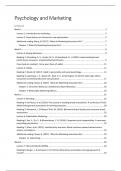Psychology and Marketing
Inhoud
Week 1..................................................................................................................................................... 3
Lecture 1: Introduction to marketing .................................................................................................. 3
Lecture 2: Guest lecture on Conversion rate optimisation ................................................................. 4
Additional reading Sharp, B. (2017). ‘What do Marketing Executives Do?’........................................ 7
Chapter 1: What Do Marketing Executives Do? .............................................................................. 7
Week 2..................................................................................................................................................... 8
Lecture 3: Buying behaviour................................................................................................................ 8
Reading 1: Ehrenberg, A. S., Uncles, M. D., & Goodhardt, G. J. (2004). Understanding brand
performance measures: using Dirichlet benchmarks. ........................................................................ 9
Case study on reading 1: Grow your share of wallet ........................................................................ 11
Lecture 4: Habits................................................................................................................................ 11
Reading 2: Wood, W. (2017). Habit in personality and social psychology. ....................................... 14
Reading 3: Labrecque, J. S., Wood, W., Neal, D. T., & Harrington, N. (2017). Habit slips: When
consumers unintentionally resist new products. .............................................................................. 17
Additional reading. Sharp, B. (2017). ‘What do Marketing Executives Do?...................................... 18
Chapter 2: Consumer Behaviour and Business Buyer Behaviour .................................................. 18
Chapter 3: Meaningful Marketing Metrics .................................................................................... 20
Week 3................................................................................................................................................... 25
Lecture 5: Branding ........................................................................................................................... 25
Reading 4: du Plessis, et al. (2024). The science of creating brand associations: A continuous Trinity
Model linking brand associations to learning processes................................................................... 28
Reading 5: Romaniuk, J., & Nenycz-Thiel, M. (2013). Behavioral brand loyalty and consumer brand
associations. ...................................................................................................................................... 29
Lecture 6: Stakeholder Marketing ..................................................................................................... 29
Reading 6: Sen, S., Du, S., & Bhattacharya, C. B. (2016). Corporate social responsibility: A consumer
psychology perspective. .................................................................................................................... 32
Reading 7: Silver, et al. (2021). Inauthenticity aversion: Moral reactance toward tainted actors,
actions, and objects........................................................................................................................... 33
Additional reading: Sharp, B. (2017). ‘What do Marketing Executives Do?...................................... 35
Chapter 11: Advertising ................................................................................................................. 35
Week 4................................................................................................................................................... 40
Lecture 7: Word-of-Mouth (WOM) ................................................................................................... 40
Reading 8: Berger, J., & Schwartz, E. M. (2011). What drives immediate and ongoing word of
mouth? .............................................................................................................................................. 43
, Reading 9: Villanueva, J., Yoo, S., & Hanssens, D. M. (2008). The impact of marketing-induced
versus word-of-mouth customer acquisition on customer equity growth. ...................................... 44
Week 5................................................................................................................................................... 45
Lecture 8: Influencer marketing ........................................................................................................ 45
Reading 9: Beichert, M., Bayerl, A., Goldenberg, J., & Lanz, A. (2024). Revenue generation through
influencer marketing. ........................................................................................................................ 47
Lecture 9: Pricing ............................................................................................................................... 48
Reading 10: Völckner, F. (2008). The dual role of price: decomposing consumers’ reactions to price
........................................................................................................................................................... 49
Reading 11: Xia, et al. (2004). The price is unfair! A conceptual framework of price fairness
perceptions........................................................................................................................................ 51
Additional reading: Sharp, B. 2017. ‘What do Marketing Executives do? ........................................ 52
Chapter 9: Pricing and discounting ............................................................................................... 52
,Week 1
Lecture 1: Introduction to marketing
A lot of products fail
- It is hard to say what makes a product successful and what not
- We cannot predict beforehand
But we can do things to create a good change to be successful→ marketing
- Is there a need/ want for it
Theodore Levitt:
- “A business suffers from marketing myopia when it defines its market too narrow, at the
level of the product rather than in terms of the customer needs”
What is marketing
= “A managerial process by which businesses try to create customer value through products and
services by doing so, aim to establish enduring, profitable customer relations”
We as consumers usually have a portfolio of brands that we choose from in a product category. So
most of us are brand switchers. This way, your buyers are the same as the buyers that buy from your
competition. So differentiating your brand is not really that important. We don’t select it on specific
characteristics, but we only distinguish brands with how they look like (the appearance). So don’t
distinguish the qualities, but the appearance.
Since we are switchers, the largest part of your consumers are one-time buyers (low-buyers). This
way, customer retention is more expensive than customer acquisition. Additionally, the best way to
promote yourself is to reach as much consumers as possible (as you don’t know who your consumers
are), so the focus is on mass marketing. Additionally, Price promotions are ineffective to increase
market share. Price is the most effective thing to affect sales; it has a big influence in buying
behaviour. BUT it does not have a long-term effect in the brand share.
With this, you do not need to know your loyal customers and brand recommendation is a poor
indication of brand strength. Attitudinal measures of quality and Perceived by the consumers are just
not that insightful.
Marketing science
, = “Empirical regularities of buying behaviour that repeat under known conditions”→ gain market
share
- Mental availability
o Customary Entry Points (CEPs)
▪ Can I easily remember it when I need to buy it
▪ Habits are important in marketing
o Distinctive assets
- Physical availability
o Presence (Is it available in the store or shop)
o Buyable (Can I easily buy it, is it affordable)
o Prominence (to stand out)
Lecture 2: Guest lecture on Conversion rate optimisation
What is CRO?
Conversion: completed goal
- Macro conversions
o Transaction, quote request
- Micro conversions
o Newsletter subscription, add to Wishlist, whitepaper download, page visit
- Conversion rate= number of (macro) conversions/ number of visitors * 100
Conversion optimisation is the practice of raising your conversion rate by compelling visitors to your
site to take specific actions like buying a product, downloading a PDF, or subscribing to a newsletter
One of the most commonly used techniques to optimise conversion rates is A/B testing
- With this method we can test the effect of changes on the website before we implement
them for every visitor
A/B testing
- Isolated experiment of a single element
- Randomised traffic allocation
More than conversion rate: strive for overall uplift of visitor effectivity
- Average order value
- Customer lifetime value
- Product returns
Psychology is an important part of CRO
- With CRO, we attempt to improve customer experience based on behaviour
- Etc.
Why CRO?
We’re not as rational as we think
System 1 vs system 2
95% is intuition and instinct, so system 1




